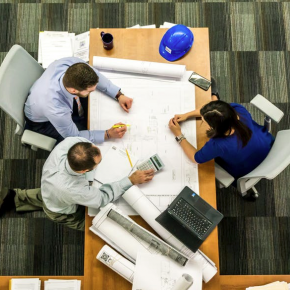
The future of architectural design
The appearance and structure of newly designed buildings has changed drastically over the last decade. Architects must now consider climate change, sustainability, an ageing population and urbanisation when designing. By 2100, the world’s population could increase to 11.2 billion, and it is estimated that almost all population growth will occur within our cities. In 1930, only 30% of the world’s population lived in cities – compared to around 50% today; by 2050 66.7% of the world’s population will live in cities.
Together with Oasys, specialists in building design and pedestrian simulation software, we explore these cutting-edge structures that are helping to accommodate our increasingly complex living-needs.
Timber is the new steel
Timber is becoming a common material used for creating tall structures. This is because it is sustainable and of high quality to create stable buildings. Moreover, CLT (cross laminated timber) regulations are sparse. With its improved strength and stability due to more sophisticated engineering techniques – wooden skyscrapers are becoming a thing of the present – not the future.
One example of an impressive structure made from CLT is Wenlock Cross in Hackney, London. More commonly known as The Cube Building, standing at 6,750sq metres, the scheme is a hybrid mix of timber and steel. The building seamlessly blends into grass parks that surround the area, but also looks right at home amongst other urbanised buildings that make up London’s metropolitan landscape. As developments progress in the construction and implementation of timber structures, only time will tell how wooden buildings will influence the future of architecture.
World’s first rotating skyscraper
Dubai is about to become home to the world’s first rotating skyscraper in the form of a dynamic tower hotel. Designed by Israeli-Italian architect, David Fisher, the structure was originally proposed in 2008 but has now been set for completion by 2020.
If the structure is built in the same way it has been designed, it is expected to change shape as it rotates – meaning that it should never look the same twice and you’ll always have a different view. Though each apartment will be able to rotate 360 degrees independently, the speed will be adjustable, and the stationary core will contain the elevator with apartments off-shooting this core.
As sustainability is a key factor in the design of buildings nowadays, this superstructure is proposed to power itself with wind turbines beneath each floor. An apartment will not come cheap, with prices set to be at around US $30 million. This is an exclusive project for those who want to pay the price to be at the forefront of innovation.
Green Structures
Architects in the East are taking inspiration from the natural greenery that is around them and utilising natural materials to create new structures, encourage biodiversity and help tropical spaces thrive.
Oasia Hotel Downtown
This hotel certainly stands out from its urban backdrop in downtown Singapore. The hotel functions as a vertical garden amongst limited green spaces. This tropical skyscraper counteracts the Central Business District within the Tanjong Pagar area, and is meant to act as a prototype for how urbans tropics will function within man-made landscapes.
Within its structure, the tower is made up of additional ground levels that act as garden spaces – providing public areas for recreation and social interaction. Each sky verandah is open sided, which provides natural breezes to pass through the building for good cross-ventilation without the need for air-conditioning units. The building is also considered a natural haven for wildlife, with an overall green plot ratio of 1,100% – reintroducing biodiversity into the city that was initially driven away through construction.
The Nanjing Green Light House
Dissimilar to the conventional light house, this structure has its name because through its round structure and sophisticated façade designs, the building is able to gain 200 LUX natural daylight for all working spaces – making it one of the first zero carbon buildings in mainland China.
Using inspiration of China’s vast and natural foliage, the building was designed with natural landscape as the most important part of the building. Through natural ventilation techniques, exposed windows and moveable skylights, anyone can enjoy this working space that incorporates natural designs.
Latest news

22nd November 2024
Insight Data: Using Marketing Data to Build a Successful Business in 2025
Alex Tremlett, Insight Data’s Commercial Director, discusses the challenges for construction firms in 2025 and shares six strategies for success…
Posted in Articles, Building Industry News, Building Services, Information Technology, news, Research & Materials Testing
22nd November 2024
Purplex: A tough Budget, but opportunity still knocks
Incoming governments, especially those with significant mandates, inevitably come into power on a tidal wave of optimism coupled with hope that ‘Things can only get better’. Andrew Scott, MD of construction-focused, full-service agency Purplex, talks…
Posted in Articles, Building Industry News, Building Services, Information Technology, news, Posts, Research & Materials Testing
22nd November 2024
Pop Up Power Supplies Gets Arty in Yorkshire
Pop Up Power Supplies has installed 13 new electricity units at The Hepworth Wakefield – read more in this article…
Posted in Articles, Building Industry News, Building Products & Structures, Building Services, Case Studies, Civil Engineering, Facility Management & Building Services, Garden, Hard Landscaping & Walkways, Landscaping, Posts, Restoration & Refurbishment, Retrofit & Renovation
22nd November 2024
OPT Services Revolutionises Fibre Cable Capping with Eco-Friendly Innovation
UK-based OPT Services has unveiled SlimLine™ Capping, a groundbreaking fibre cable protection solution that promises to deliver significant environmental and installation advantages to the fibre optic industry.
Posted in Articles, Building Industry News, Building Products & Structures, Building Services, Facility Management & Building Services, Information Technology, Innovations & New Products, Sustainability & Energy Efficiency
 Sign up:
Sign up: